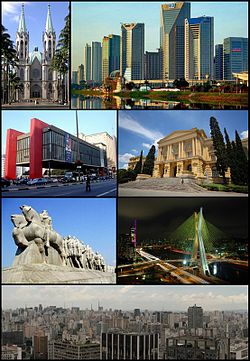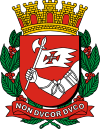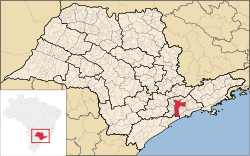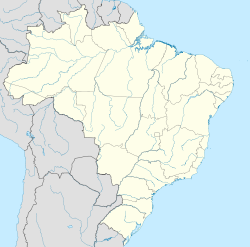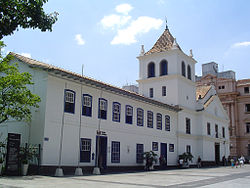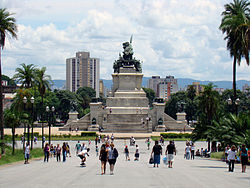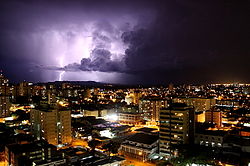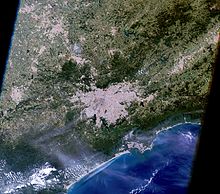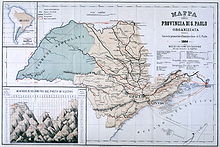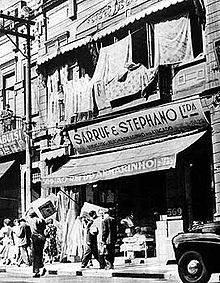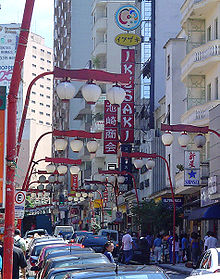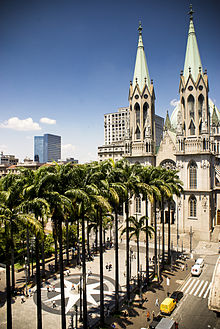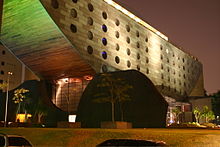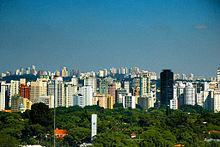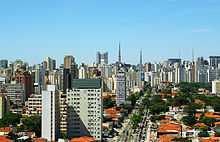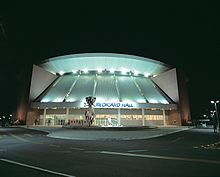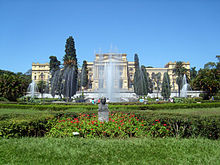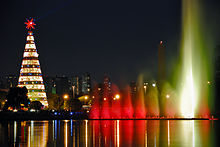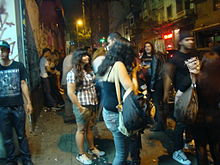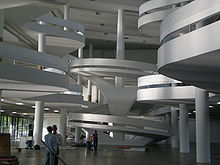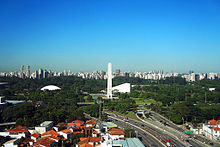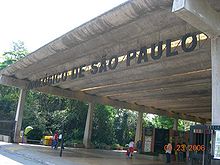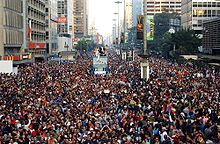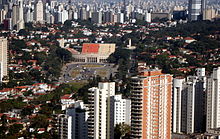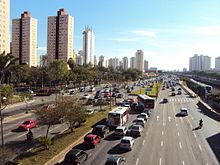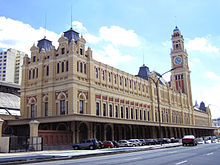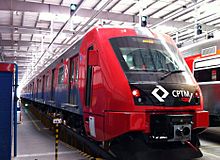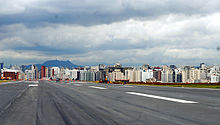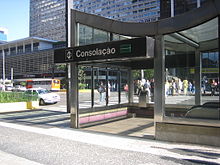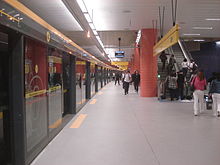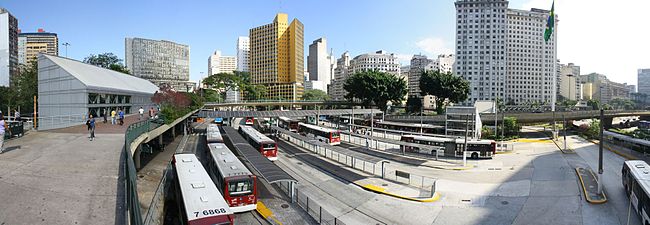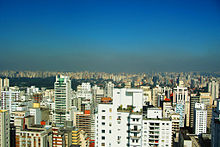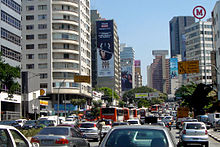
São Paulo
Background Information
SOS Children offer a complete download of this selection for schools for use on schools intranets. SOS Child sponsorship is cool!
| São Paulo | |||
|---|---|---|---|
| — Municipality — | |||
| Município de São Paulo Municipality of São Paulo |
|||
| Photo montage of the city of São Paulo. From the top, left to right: São Paulo Cathedral; United Nations Business Centre; São Paulo Museum of Art on Paulista Avenue; Museum of Ipiranga; Bandeiras Monument; Octávio Frias de Oliveira Bridge; and downtown skyline from Altino Arantes Building. | |||
|
|||
| Nickname(s): Terra da Garoa (Land of Drizzle) and Sampa | |||
| Motto: "Non ducor, duco" (Latin) "I am not led, I lead" |
|||
|
|
|||
| Coordinates: 23°33′S 46°38′W Coordinates: 23°33′S 46°38′W | |||
| Country | Brazil | ||
| Region | Southeast | ||
| State | |||
| Founded | 1554 | ||
| Government | |||
| • Mayor | Fernando Haddad (2013–2017) |
||
| Area | |||
| • Municipality | 1,522.986 km2 (588.028 sq mi) | ||
| • Metro | 7,943.818 km2 (3,067.125 sq mi) | ||
| Elevation | 760 m (2,493.4 ft) | ||
| Population (2011) | |||
| • Municipality | 11,316,149( 1st) | ||
| • Density | 7,216.3/km2 (18,690/sq mi) | ||
| • Metro | 19,889,559 | ||
| • Metro density | 2,469.35/km2 (6,395.6/sq mi) | ||
| Demonym | Paulistano | ||
| Time zone | BRT ( UTC−3) | ||
| • Summer ( DST) | BRST ( UTC−2) | ||
| Postal Code (CEP) | 01000-000 | ||
| Website | www.prefeitura.sp.gov.br | ||
São Paulo ( / ˌ s aʊ ˈ p aʊ l oʊ /; Portuguese pronunciation: [sɐ̃w ˈpawlu]; Saint Paul) is the largest city in Brazil, the largest city proper in the southern hemisphere and Americas and the world's eighth largest city by population. The metropolis is anchor to the São Paulo metropolitan area, ranked as the second most populous metropolitan area in the Americas and among the ten largest metropolitan areas on the planet. São Paulo is the capital of the state of São Paulo, Brazil's most populous state. It exerts strong regional influence in commerce, finance, arts and entertainment and a strong international influence. The name of the city honours Saint Paul of Tarsus.
São Paulo has the largest economy, by GDP, among Latin American and Brazilian cities. Its GDP per capita is the fifth highest among the larger Latin American cities and Brazil's second highest, behind Brasília.
The metropolis has significant cultural, economic and political influence both nationally and internationally. It is home to several important monuments, parks and museums such as the Latin American Memorial, the Museum of the Portuguese Language, São Paulo Museum of Art, Museum of Ipiranga and the Ibirapuera Park. Paulista Avenue is the most important financial centre of São Paulo. The city holds many high profile events, like the São Paulo Art Biennial, the Brazil Grand Prix Formula 1 Sao Paulo, Sao Paulo Fashion Week, ATP Brasil Open and the São Paulo Indy 300. Sao Paulo hosts the world's largest gay pride parade according to the Guinness Book of World Records.
It is home to the São Paulo Stock Exchange, the Future Markets and the Cereal Market Stock Exchanges (the second largest stock exchange in the World, in market value). São Paulo is home to several of the tallest buildings in Brazil, including the building Mirante do Vale, Italia, Altino Arantes, North Tower of the UNSCOM (United Nations Centre Enterprise) and many others.
People from the city of São Paulo are known as paulistanos, while paulistas designates anyone from the surrounding state, including the paulistanos. The city's Latin motto, which it has shared with the battleship and the aircraft carrier named after it, is Non ducor, duco, which translates as "I am not led, I lead."
The city, which is also colloquially known as "Sampa" or "Cidade da Garoa" (city of drizzle), is also known for its unreliable weather, the size of its helicopter fleet, its architecture, gastronomy, severe traffic congestion and multitude of skyscrapers. The city is considered an alpha world city according to the Global City economic system. According to one source, São Paulo is expected to have the second highest economic growth in the world between 2011 and 2025, although New York City and Tokyo were expected to remain the largest in 2025.
History
Colonial period
The village of São Paulo dos Campos de Piratininga appeared on January 25, 1554, with the construction of the Colégio de São Paulo de Piratininga, a Jesuit college of twelve priests, among them Manuel da Nobrega and Jose de Anchieta, on top of a steep hill between the rivers Anhangabaú and Tamanduateí. This school, which operated in a shack made of rammed earth, had, on purpose, catechesis of the Indians who lived in the Plateau region of Piratininga, separated from the coast by the Serra do Mar, called by the Indians "Serra Paranapiacaba."
The name was chosen because the college was founded on January 25, the same day on which the Catholic Church celebrates the conversion of the Apostle Paul of Tarsus, according to Father José de Anchieta in a letter to the Society of Jesus:
The Year January 25, 1554 we celebrate the Lord in impoverished and very narrow house, the first Mass on the day of the conversion of Paul of Tarsus and the Apostle Paul, so he dedicated to our house!
The settlement of the region's Courtyard of the College began in 1560. During the visit of Mem de Sá, Governor-General of Brazil, the Captaincy of São Vicente, he ordered the transfer of the population of the Village of Santo André da Borda do Campo to the vicinity of the college. It was then named "College of St. Paul Piratininga". The new location was on a steep hill adjacent to a large wetland, the lowland do Carmo. It offered better protection from attacks by local Indian groups. It was renamed Vila de São Paulo, belonging to the Captaincy of São Vicente.
For the next two centuries São Paulo remained a poor and isolated village surviving through cultivation of subsistence crops. São Paulo was for a long time the only village in Brazil's interior. This isolation was mainly because it was difficult to travel the Serra do Mar walk from the village of Santos and the Town of Vincent to Piratininga Plateau. Mem de Sá forbade the use of "Path Piraiquê" (Piaçaguera today), because of frequent Indian raids.
On March 22, 1681, the Marquis de Cascais, the donee of the Captaincy of São Vicente, moved the capital to the village of St. Paul, designating it the "Head of the captaincy." The new capital was established in April 23, 1683, with large public celebrations.
São Paulo was the poorest region of the Portuguese colony. It hosted the activity of the pioneers, who were scattered across the countryside hunting for Indians. Because they were extremely poor, the Paulistas could not afford African slaves. The discovery of gold in the region of Minas Gerais, in the 1690s, turned attention to São Paulo. The new Real Captaincy of São Paulo and Minas do Ouro was created in November 3, 1709, when the Portuguese crown purchased the Captaincy of São Paulo and Santo Amaro Captaincy from his former grantees. On July 11, 1711, the Town of St. Paul was elevated to city status. Around 1720, gold was found by the pioneers in the regions near what is now Cuiabá and Goiás city, which expanded Brazilian territory beyond the Line of Tordesillas.
When the gold ran out in the late eighteenth century, São Paulo shifted to growing sugar cane, which spread through the interior of the Captaincy. The sugar was exported through the Port of Santos. At that time, the first modern highway between São Paulo and the coast was constructed and named the Walk of Lorraine.
Imperial Period
After the Independence of Brazil, declared by Dom Pedro I where is now located the Monument of Ipiranga, São Paulo received the title of Imperial City, awarded by Dom Pedro I of Brazil in 1823. In 1827, a law school was founded at the Convent of São Francisco, today part of USP. The subsequent influx of students and teachers gave a new impetus to the city's growth, thanks to which, the city became the Imperial city and Borough of Students of St. Paul Piratininga.
The expansion of coffee production was another factor in the growth of São Paulo, initially in the Vale do Paraíba and then in the regions of Campinas, Rio Claro, São Carlos and Ribeirão Preto.
From 1869 onwards, São Paulo was connected to the port of Santos by the Railroad Santos-Jundiaí, called The Lady. In the late nineteenth century, several other railroads connected the interior to the state capital. São Paulo became the point of convergence of all railroads from the interior of the state. Coffee allowed the State of São Paulo to experience major economic and population growth.
From the middle of the XIX century to its end, the province began to receive a large number of immigrants, largely Italians and Portuguese, many of whom settled in the capital. The region's first industries also began to emerge.
Geography
Physical setting
São Paulo is located in Southeastern Brazil, in southeastern São Paulo State, approximately halfway between Curitiba and Rio de Janeiro. The city is located on a plateau located within the Serra do Mar (Portuguese for "Sea Range"), itself a component of the vast region known as the Brazilian Highlands, with an average elevation of around 799 metres (2,621 ft) above sea level, although being at a distance of only about 70 kilometres (43 mi) from the Atlantic Ocean. This distance is covered by two highways, the Anchieta and the Imigrantes, (see "Transportation" below) that roll down the range, leading to the port city of Santos and the beach resort of Guarujá. Rolling terrain prevails within the urbanized areas of São Paulo except in its northern area, where the Serra da Cantareira Range reaches a higher elevation and a sizable remnant of the Atlantic Rain Forest. The region is seismically stable and no significant seismic activity has ever been recorded.
The Tietê River and its tributary, the Pinheiros River, were once important sources of fresh water and leisure for São Paulo. However, heavy industrial effluents and wastewater discharges in the later 20th century caused the rivers to become heavily polluted. A substantial clean-up program for both rivers is underway, financed through a partnership between local government and international development banks such as the Japan Bank for International Cooperation. Neither river is navigable in the stretch that flows through the city, although water transportation becomes increasingly important on the Tietê river further downstream (near river Paraná), as the river is part of the River Plate basin.
No large natural lakes exist in the region, but the Billings and Guarapiranga reservoirs in the city's southern outskirts are used for power generation, water storage and leisure activities, such as sailing. The original flora consisted mainly of a great variety of broadleaf evergreens. Today, non-native species are common, as the mild climate and abundant rainfall permit a multitude of tropical, subtropical and temperate plants to be cultivated, especially the ubiquitous eucalyptus.
Climate
The city has a monsoon-influenced humid subtropical climate (Cfa/Cwa), according to the Köppen classification. In summer, mean temperatures are between 17 °C (63 °F) and 28 °C (82 °F) and 32 °C (90 °F) on the hottest days. In winter, are between 11 °C (52 °F) and 23 °C (73 °F) and 6 °C (43 °F). The recorded high was 35.3 °C (95.5 °F) on November 15, 1985 and the lowest −2 °C (28 °F) on August 2, 1955 and on the same day −3.8 °C (25.2 °F) was recorded unofficially. Temperature averages are similar to those of Sydney and Los Angeles. The Tropic of Capricorn, at about 23°27' S, passes through north of São Paulo and roughly marks the boundary between the tropical and temperate areas of South America. Because of its elevation, however, São Paulo enjoys a distinctly temperate climate.
Rainfall is abundant, annually averaging 1,454 millimetres (57.2 in). It is especially common in the warmer months averaging 219 millimetres (8.6 in) and decreases in winter, averaging 47 millimetres (1.9 in). Neither São Paulo nor the nearby coast has ever been hit by a tropical cyclone and tornadic activity is uncommon. During late winter, especially August, the city experiences the phenomenon known as "veranico" or "verãozinho" ("little summer"), which consists of hot and dry weather, sometimes reaching temperatures well above 28 °C (82 °F). On the other hand, relatively cool days during summer are fairly common when persistent winds blow from the ocean. On such occasions daily high temperatures may not surpass 20 °C (68 °F), accompanied by lows often below 15 °C (59 °F), however, summer can be extremely hot when a heat wave hits the city followed by temperatures around 34 °C (93 °F), but in places with greater skyscraper density and less tree cover, the temperature can feel like 39 °C (102 °F), as on Paulista Avenue for example. In the summer of 2012, São Paulo was affected by a heat wave that lasted for 2 weeks with highs going from 29 °C (84 °F) to 34 °C (93 °F) on the hottest days.
São Paulo is also known for its rapidly changing weather. Locals say that you can experience all four seasons in one day. In the morning, when winds blow from the ocean, the weather can be cool or sometimes even cold. When the sun hits its peak, the weather can be extremely dry and hot. When the sun sets, the cold wind comes back bringing cool temperatures. This phenomenon happens usually in the winter.
| Climate data for São Paulo (1961 - 1990, records lows since 1931) | |||||||||||||
|---|---|---|---|---|---|---|---|---|---|---|---|---|---|
| Month | Jan | Feb | Mar | Apr | May | Jun | Jul | Aug | Sep | Oct | Nov | Dec | Year |
| Record high °C (°F) | 34.2 (93.6) |
34.6 (94.3) |
33.6 (92.5) |
31.3 (88.3) |
29.8 (85.6) |
28.9 (84) |
29.3 (84.7) |
33 (91) |
37.4 (99.3) |
34.4 (93.9) |
35.2 (95.4) |
35.7 (96.3) |
37.4 (99.3) |
| Average high °C (°F) | 27.4 (81.3) |
28 (82) |
27.3 (81.1) |
25.1 (77.2) |
23 (73) |
21.7 (71.1) |
21.8 (71.2) |
23.3 (73.9) |
23.9 (75) |
24.7 (76.5) |
25.9 (78.6) |
26.3 (79.3) |
24.5 (76.1) |
| Daily mean °C (°F) | 22.2 (72) |
22.4 (72.3) |
21.7 (71.1) |
19.8 (67.6) |
17.6 (63.7) |
16.4 (61.5) |
15.8 (60.4) |
17.1 (62.8) |
17.8 (64) |
19 (66) |
20.3 (68.5) |
21.2 (70.2) |
18.5 (65.3) |
| Average low °C (°F) | 18.7 (65.7) |
18.8 (65.8) |
18.2 (64.8) |
16.3 (61.3) |
13.9 (57) |
12.3 (54.1) |
11.7 (53.1) |
12.8 (55) |
13.9 (57) |
15.3 (59.5) |
16.5 (61.7) |
17.8 (64) |
14.5 (58.1) |
| Record low °C (°F) | 10.2 (50.4) |
11.2 (52.2) |
10.9 (51.6) |
6 (43) |
5.2 (41.4) |
0.9 (33.6) |
0.2 (32.4) |
−2.2 (28) |
2.1 (35.8) |
4.2 (39.6) |
6.9 (44.4) |
7.3 (45.1) |
−2.2 (28) |
| Precipitation mm (inches) | 240 (9.45) |
250 (9.84) |
160 (6.3) |
80 (3.15) |
70 (2.76) |
60 (2.36) |
40 (1.57) |
30 (1.18) |
70 (2.76) |
130 (5.12) |
140 (5.51) |
190 (7.48) |
1,460 (57.48) |
| Avg. precipitation days | 18 | 16 | 13 | 9 | 9 | 6 | 7 | 7 | 9 | 11 | 13 | 16 | 134 |
| Mean monthly sunshine hours | 148.8 | 150.8 | 145.7 | 141.0 | 151.9 | 144.0 | 164.3 | 155.0 | 126.0 | 136.4 | 144.0 | 130.2 | 1,738.1 |
| Source #1: INMET — Clima, Hong Kong Observatory for data of sunshine hours | |||||||||||||
| Source #2: World Weather Information Service, for data of precipitation days | |||||||||||||
Metropolitan area
The nonspecific term "Grande São Paulo" ("Greater São Paulo") covers multiple definitions. The legally defined Região Metropolitana de São Paulo consists of 39 municipalities in total and a population of 19,889,559 inhabitants (as of 2010 National Census).
Because São Paulo has significant urban sprawl, it uses a different definition for its metropolitan area, Complexo Metropolitano Expandido. Analogous to the US's CSA ( Combined Statistical Area) definition, it is the third largest city in the world with 27 million inhabitants, behind Tokyo and Jakarta, which includes 2 contiguous legally defined metropolitan regions and 3 microregions.
Subdivisions
The city of São Paulo is divided into 31 subprefectures (subprefeituras), in turn divided into 96 districts. Locally, districts contain one or more neighborhoods ( bairros). The subprefectures are officially grouped into nine regions (or "zones"), taking into account their geography and history of occupation. These regions are used only in technical and governmental agencies and are not identified by any visible features.
A geographic radial division was established in 2007 by mayor Gilberto Kassab. These geographical areas (historical downtown, extended downtown, north, south, east, west, northeast, northwest, southeast and southwest) are each identified with a distinct colour on bus maps and in the street signs. These are not related to subprefectures and districts.
Demographics
In 2010, São Paulo was the most populous city in Brazil and in South America. According to the 2010 IBGE Census, there were 10,659,386 people residing in the city of São Paulo. The census found 6,824,668 White Brazilians (60.6%), 3,433,218 Browns ( Multiracial) (30.5%), 736,083 Afro-Brazilians (6.5%), 246,244 Asian Brazilian (2.2%) and 21,318 Amerindian (0.2%).
In 2010, the city had 2,146,077 opposite-sex couples and 7,532 same-sex couples. The population of São Paulo was 52.6% female and 47.4% male.
Immigration
São Paulo is the country's most ethnically diverse city. When slave trafficking ended in Brazil (1850), São Paulo started to replace African labor with voluntary immigrants in the coffee plantations. The pioneer in this new project was senator Nicolau Vergueiro, who brought many German, Swiss and Portuguese immigrants to work in his own properties. The next waves of immigrants contained Italians and Portuguese from the mid-19th century until the start of the 20th century. These were far more adaptable to coffee cultivation and became over time the largest immigrant communities in the state of São Paulo.
After the abolition of slavery (1888), São Paulo received increasing numbers of European immigrants, most from Italy, followed by Portugal, Germany and Spain. In 1897, Italians made up over half of the city's population. Portuguese, Spaniards, Germans, Japanese, Jews, Armenians and Christian Syrian-Lebanese as well as Eastern-Europeans also came in significant numbers. From 1908 to 1941, many Japanese immigrants arrived. In the 1960s, Chinese and Koreans started arriving. In the mid-20th century, many from the drought-stricken Northeastern Brazil started to migrate to São Paulo. Nowadays, the city is witness to a large wave of Bolivian migration.
| Immigrants | Percentage of immigrants in foreign born population |
|---|---|
| Italians | 47.9% |
| Portuguese | 29.3% |
| Germans | 9.9% |
| Spaniards | 3.2% |
A French observer, travelling to São Paulo at the time, noted that there was a division of the capitalist class, by nationality (...) Germans, French and Italians shared the dry goods sector with Brazilians. Foodstuffs was generally the province of either Portuguese or Brazilians, except for bakery and pastry which was the domain of the French and Germans. Shoes and tinware were mostly controlled by Italians. However, the larger metallurgical plants were in the hands of the English and the Americans. (...) Italians outnumbered Brazilians two to one in São Paulo.
Until 1920, 1,078,437 Italians entered in the State of São Paulo. Of the immigrants who arrived there between 1887 and 1902, 63.5% came from Italy. Between 1888 and 1919, 44.7% of the immigrants were Italians, 19.2% were Spaniards and 15.4% were Portuguese. In 1920, nearly 80% of São Paulo city's population was composed of immigrants and their descendants and Italians made up over half of its male population. At that time, the Governor of São Paulo said that "if the owner of each house in São Paulo display the flag of the country of origin on the roof, from above São Paulo would look like an Italian city". In 1900, a columnist who was absent from São Paulo for 20 years wrote "then São Paulo used to be a genuine Paulista city, today it is an Italian city."
| Year | Italians | Percentage of the City |
|---|---|---|
| 1886 | 5,717 | 13% |
| 1893 | 45,457 | 35% |
| 1900 | 75,000 | 31% |
| 1910 | 130,000 | 33% |
| 1916 | 187,540 | 37% |
Research conducted by the University of São Paulo (USP) shows the city's high ethnic diversity: when asked if they are "descendants of foreign immigrants", 81% of the students reported "yes". The main reported ancestries were: Italian (30.5%), Portuguese (23%), Spanish (14%), Japanese (8%), German (5.6%), Brazilian (4.3%), African (2.8%), Arab (2.4%) and Jewish (1.2%).
Domestic migration
Since the 19th century people began migrating from Northeastern Brazil into São Paulo. This migration grew enormously in the 1930s and remained huge in the next decades. The concentration of land, modernization in rural areas, changes in work relationships and cycles of droughts stimulated migration. Northeastern migrants live mainly in hazardous and unhealthy areas of the city, in cortiços, in various slums ( favelas) of the metropolis, because they offer cheaper housing. According to the 2000 Brazilian Census, 3,641,148 people from Northeastern Brazil lived in São Paulo, about 20% of the city's population. According to another resource, the largest concentration of Northeastern migrants was found in the area of Sé/Brás (districts of Brás, Bom Retiro, Cambuci, Pari and Sé). In this area they composed 41% of the population.
As in all of Brazil, people of different ethnicities mix with each other, producing a multi-ethnic society. Today, people of many different ethnicities make São Paulo their home. The main groups, considering all the metropolitan area, are: 6 million people of Italian descent, 3 million people of Portuguese descent, 1.7 million people of African descent, 1 million people of Arab descent, 665,000 people of Japanese descent, 400,000 people of German descent, 250,000 people of French descent, 150,000 people of Greek descent, 120,000 people of Chinese descent, 60,000 Bolivian immigrants, 50,000 people of Korean descent, and 40,000 Jews.
Changing demographics of the city of São Paulo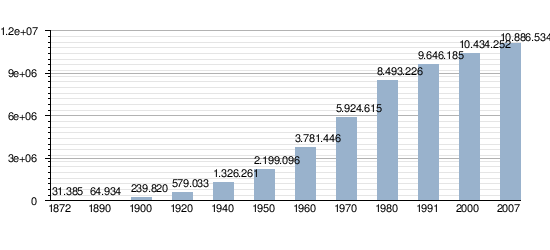
Source: Planet Barsa Ltda.
Religion
| Religion | Percentage | Number |
|---|---|---|
| Catholic | 58.20% | 6,549,775 |
| Protestant | 22.11% | 2,487,810 |
| No religion | 9.38% | 1,056,008 |
| Spiritist | 4.73% | 531,882 |
| Buddhist | 0.67% | 75,075 |
| Umbanda and Candomblé | 0.62% | 69,706 |
| Jewish | 0.39% | 43,610 |
Source: IBGE 2010.
Languages
The primary language is Portuguese. Due to the large influx of Italian immigrants, the Portuguese spoken in the city reflects a significant influence from the languages of the Italian peninsula, particularly from Neapolitan and Venetian.
Italian dialects mix with the countryside Caipira accent of São Paulo. Some linguists maintain that the São Paulo dialect of Portuguese was born in Mooca, a neighbourhood settled in the early 20th century mainly by people from Naples, Southern Italy.
The Italian influence in São Paulo accents is more evident in the traditional Italian neighborhoods such as Bella Vista, Mooca, Brás and Lapa. Italian mingled with Portuguese and as an old influence, was assimilated or disappeared into spoken language. The local accent with Italian influences became notorious through the songs of Adoniran Barbosa, a Brazilian samba singer born to Italian parents who used to sing using the local accent.
Other languages spoken in the city are mainly among the Asian community: the Liberdade neighbourhood is home to the largest Japanese population outside of Japan. Although today most Japanese-Brazilians speak only Portuguese, some of them are still fluent in Japanese. Some people of Chinese and Korean descent are still able to speak their ancestral languages.
In some areas it is still possible to find descendants of immigrants who speak German (especially in the area of Brooklin paulista) and Russian or East European languages (especially in the area of Vila Zelina). In the west zone of São Paulo, specially at Vila Anastácio and Lapa region, there is a Hungarian colony, with 3 churches (Calvinist, Baptist and Catholic), so on Sundays was possible to see, Hungarians talking to each other on walksides.
Statistics
| Category | Data |
|---|---|
| Vehicles | 7,081,778 (June 2011) |
| Daily newspapers | 34 (September 2008). |
| Helicopters | World's largest fleet |
| Urban area | 1,968 km² (760 sqmi) |
| Air passenger traffic | 47,723,894 (2010) Cumbica, Congonhas, Viracopos, Campo de Marte, São José dos Campos), the largest in Southern Hemisphere. |
| Buildings | 3rd-most highrise buildings with 5,644, according to Emporis database. Largest shopping centre in Latin America, the Centro Comercial Leste Aricanduva with365,000 m2 (3,928,827.30 sq ft) of built area and 242,300 m2 (2,608,095.49 sq ft) of gross leasable area. |
| Rail passenger traffic per day | 6 million passengers in the São Paulo metro and the CPTM (3.7 million and 2.3 million respectively). |
| Hospitals | Largest complex in Latin America, the Hospital das Clínicas of the University of São Paulo with 352,000 m2 (3,788,896.47 sq ft) of built area. |
| Billionaires | 21: 6th most in the world, tied with Mumbai |
| GDP | Greater São Paulo is the world's 10th richest city in 2008 with GDP ( PPP) of $388 billion |
Economy
São Paulo is considered the "financial capital of Brazil", as it is the location for the headquarters of many major corporations and the country's most renowned banks and financial institutions. Sao Paulo is Brazil's highest GDP city and the 10th largest in the world, using Purchasing power parity. According to data of IBGE, its gross domestic product (GDP) in 2010 was R$ 450 billion, approximately $220 billion, 12.26% of Brazilian GDP and 36% of all production of goods and services of the State of São Paulo. According to PricewaterhouseCoopers average annual economic growth of the city is 4.2%.
São Paulo's economy is going through a deep transformation. Once a city with a strong industrial character, São Paulo's economy has followed the global trend of shifting to the tertiary sector of the economy, focusing on services. The city is unique among Brazilian cities for its large number of foreign corporations. 63% of all the international companieswith business in Brazil have their head offices in São Paulo. São Paulo has the largest concentration of German businesses worldwide and is the largest Swedish industrial hub alongside Gothenburg.
São Paulo also has a large "informal" economy.
The per capita income for the city was R$ 32,493 (2008). In 2005, the city of São Paulo collected R$ 90 billion in taxes and the city budget was R$ 15 billion. The city has 1,500 bank branches and 70 shopping malls.
The São Paulo Stock Exchange (BM&F Bovespa) is Brazil's official stock and bond exchange. It is the largest stock exchange in Latin America, trading about R$ 6 billion (US$ 3.5 billion) every day.
According to Mercer's 2011 city rankings of cost of living for expatriate employees, São Paulo is now among the ten most expensive cities in the world, ranking 10th in 2011, up from 21st in 2010 and ahead of London, Paris, Milan and New York City.
| Companies in Financial Times Global 500 of São Paulo in 2012 | ||||||
| SP | Corporation | BRA | World | |||
| 1 | Ambev | 1 | 43 | |||
| 2 | Itau Unibanco | 4 | 100 | |||
| 3 | Bradesco | 5 | 127 | |||
| 4 | Banco Santander Brasil | 6 | 260 | |||
| 5 | Telefonica Brasil | 8 | 282 | |||
| 6 | Itausa | 9 | 348 | |||
| 7 | Cielo | 10 | 423 | |||
Science and technology
The city of São Paulo is home to several important Research and Development facilities and attracta companies due to the presence of several regionally renowned universities. Science, technology and innovation is leveraged by the allocation of funds from the state government, mainly carried out by means of the Foundation to Research Support in the State of São Paulo (Fundação de Amparo à Pesquisa do Estado de São Paulo – FAPESP), one of the main agencies promoting scientific and technological research.
Luxury goods
Sales of luxury goods in Brazil amounted to 8.9 billion dollars in 2010, according to GfK Brazil, of which 70% are sold in São Paulo City. 95% of sales in the city take place in the 'luxury quadrilateral'. The Shopping Cidade Jardim is a relatively new, high-end mall, in Jardim Panorama, Morumbi district, with restaurants, cinemas and boutiques.
The Iguatemi Faria Lima, in Faria Lima Avenue, is the Brazil's oldest mall, opened in 1966. It is considered the 11th most expensive shopping area in the world, according to Cushman & Wakefield. More than 30 international luxury brands are there.
The latest high-end mall of the city, JK Iguatemi, is in the Vila Olímpia neighbourhood with over 50 international brands.
The Jardins neighbourhood is regarded among the most sophisticated places in town, with upscale restaurants and hotels. The New York Times once compared Oscar Freire Street to Rodeo Drive.
In Jardins there are many luxury car dealers. One of the world's best restaurants as elected by The World's 50 Best Restaurants Award, D.O.M., is located there.
Outside the 'luxury quadrilateral', is the Brooklin CBD. This neighbourhood has some of the city's most luxurious hotels and another shopping mall, Morumbi Shopping. Other regions of the city also have luxury trade as Jardim Anália Franco (East Zone), Higienópolis (Central Zone), Alto de Santana (North Zone), Alto de Pinheiros (West Zone), Moema/Vila Nova Conceição (South Zone) and Alphaville ( Barueri municipality, Greater São Paulo).
Urban planning
São Paulo has a history of actions, projects and plans related to urban planning that can be traced to the governments of Antonio da Silva Prado, Baron Duprat, Washington and Luis Francisco Prestes Maia. However, in general, the city was formed during the twentieth century, growing from village to metropolis through a series of informal processes and irregular urban sprawl.
Thus, São Paulo differs considerably from other Brazilian cities such as Belo Horizonte and Goiânia, whose initial expansion followed determinations by a plan, or a city like Brasília, whose master plan had been fully developed prior to construction.
The effectiveness of these plans has been seen by some planners and historians as questionable. Some of these scholars argue that such plans were produced exclusively for the benefit of the wealthier strata of the population while the working classes would be relegated to the traditional informal processes.
In São Paulo until the mid-1950s, the plans were based on the idea of "demolish and rebuild", including former Mayor Prestes Maia São Paulo's road plan (known as the Avenues Plan) or Saturnino de Brito's plan for the Tietê River.
In 1968 the Urban Development Plan proposed the Basic Plan for Integrated Development of São Paulo, under the administration of Figueiredo Ferraz. The main result was zoning laws. It lasted until 2004 when the Basic Plan was replaced by the current Master Plan.
That zoning, adopted in 1972, designated "Z1" areas (residential areas designed for elites) and "Z3" (a "mixed zone" lacking clear definitions about their characteristics). Zoning encouraged the growth of suburbs with minimal control and major speculation.
Education
São Paulo has a system of public and private primary and secondary schools and a variety of vocational- technical schools. More than nine-tenths of the population are literate and roughly the same proportion of those age 7 to 14 are enrolled in school. There are more than 578 universities in the whole state of São Paulo.
Among the institutions of higher education, the largest and most well-regarded is the state-financed University of São Paulo (USP), established in 1934, which incorporated the historic Law School (Faculdade de Direito) in the old Largo São Francisco in the city centre. USP enrolls a high proportion of Brazil's doctoralstudents and has spawned a wide variety of research institutes and policy centres. Affiliated institutions include the Butantan Institute, a world-famous centre for research on snakes and the production of snake toxins and anti-toxins.
The Universidade Presbiteriana Mackenzie(Mackenzie Presbyterian University), first as Mackenzie College, in 1870, then as a university after 1952, is among the leading religious institutions in the city. It was established as a private grammar school by North American missionary Reverend George Whitehill Chamberlain and his wife Mary Annesley inside their home. In 1896, John Theron Mackenzie, an attorney from Phelps, New York and his sisters donated US$50,000 "for the establishment of an engineering school to be built under the auspices of Mr. Chamberlain". The Mackenzie building was built the next year and the college was named in their honour. The institution saw rapid expansion with the creation of a School of Architecture, a School of Economics and a Law School, gaining the status of university in 1952.
The Pontifical Catholic University of São Paulo was established in 1946. The Business and Management School of the Getúlio Vargas Foundation is another prominent institution.
Educational institutions
The city has several universities and colleges:
- Universidade de São Paulo (USP) (University of São Paulo);
- Pontifícia Universidade Católica de São Paulo (PUC-SP) (Pontifical Catholic University of São Paulo);
- Instituto Federal de Educação, Ciência e Tecnologia de São Paulo (IFSP) (São Paulo Federal Institute of Education, Science and Technology);
- Universidade Estadual Paulista Júlio de Mesquita Filho (Unesp) (São Paulo State University Júlio de Mesquita Filho);
- Faculdade de Tecnologia de São Paulo (FATEC) (São Paulo Technological College);
- Universidade Federal de São Paulo (UNIFESP) (Federal University of São Paulo);
- Centro Universitário Belas Artes de São Paulo;
- Universidade Nove de Julho (UNINOVE) (Ninth of July University);
- Universidade de Mogi das Cruzes (UMC) (University of Mogi das Cruzes);
- Universidade Presbiteriana Mackenzie (MACKENZIE-SP) (Mackenzie Presbyterian University)
- Universidade São Judas Tadeu (USJT) (São Judas Tadeu University/"São Judas University");
- Escola Superior de Propaganda e Marketing (ESPM-SP) (Superior School of Advertising and Marketing);
- Fundação Getúlio Vargas (FGV-SP) (Getúlio Vargas Foundation);
- Fundação Escola de Comércio Álvares Penteado (FECAP) (School of Commerce Alvares Penteado Foundation);
- Fundação Armando Alvares Penteado (FAAP) (Armando Alvares Penteado Foundation);
- Universidade Anhembi Morumbi (Anhembi Morumbi University);
- Faculdades Metropolitanas Unidas (FMU) (UMC, United Metropolitan Colleges);
- Instituto Brasileiro de Mercado de Capitais (Ibmec-SP) (Brazilian Capital Market Institute);
- Faculdade de Comunicação Social Cásper Líbero (Cásper Líbero Social Communication College);
- Faculdade Santa Marcelina (FASM) (Santa Marcelina College)
Health care
São Paulo is the largest health care hub in Latin America. Among its best hospitals are the Albert Einstein Israelites Hospital, ranked as the best in Latin America and the Hospital das Clínicas, the largest in the region. The private health care sector is very large and most of Brazil's best hospitals are located in the city. As of September 2009, the city of São Paulo had:
- 32,553 ambulatory clinics, centers and professional offices (physicians, dentists and others);
- 217 hospitals, with 32,554 beds;
- 137,745 health care professionals, including 28,316 physicians.
Municipal health
The municipal government operates public health facilities across the city's territory, with a grand total of 770 basic health care units (UBS), ambulatory and emergency clinics and 17 hospitals. The Municipal Secretary of Health has 59,000 employees, including more than 8,000 physicians and 12,000 nurses.
More than 6,000,000 citizens uses these facilities, which provide drugs at no cost and manage an extensive family health program (PSF – Programa de Saúde da Família).
The Rede São Paulo Saudável (Healthy São Paulo Network) is a satellite-based digital TV corporate channel, developed by the Municipal Health Secretary of São Paulo, bringing programs focused on health promotion and health education, which may be watched by citizens seeking health care in its units in the city.
The network consists of two studios and a system for transmission of closed digital video in high definition via satellite, with about 1,400 points of reception in all health care units of the municipality of São Paulo.
Culture
Music
Adoniran Barbosa was a famous samba singer and composer who became successful during São Paulo's early radio era. Born in 1912 in the town of Valinhos, Barbosa was known as the "composer to the masses", particularly Italian immigrants living in the quarters of Bela Vista, also known as "Bexiga" and Brás, as well as those who lived in the city's many 'cortiços' or tenements. His songs drew from the life of urban workers, the unemployed and those who lived on the edge. His first big hit was "Saudosa Maloca" ("Shanty of Fond Memories" – 1951), wherein three homeless friends recall with nostalgia their improvised shanty home, which was torn down by the landowner to make room for a building. His 1964 Trem das Onze ("The 11 pm Train"), became one of the five best samba songs ever, the protagonist explains to his lover that he cannot stay any longer because he has to catch the last train to the Jaçanã suburb, for his mother will not sleep before he arrives home. Another important musician with a similar style is Paulo Vanzoline. Vanzoline is a PhD in Biology and a part-time professional musician. He composed a song depicting a love murder scene in São Paulo called "Ronda".
In the late 1960s, a psychedelic rock band called Os Mutantes became popular. Their success is related to that of other tropicalia musicians. The group were known as very paulistanos in their behaviour and clothing. Os Mutantes released five albums before lead singer Rita Lee departed in 1972 to form another group called Tutti-Frutti. Although initially known only in Brazil, Os Mutantes became successful abroad after the 1990s. In 2000, Tecnicolor, an album recorded in the early 1970s in English by the band, was released with artwork designed by Sean Lennon.
In the early 1980s, a band called Ultrage a Rigor (Elegant Outrage) emerged. They played a simple and irreverent style of rock. The lyrics depicted the changes in society and culture that Brazilian society as a whole were experiencing at the time. A late punk and garage scene became strong in the 1980s, perhaps associated with the gloomy scenario of unemployment during an extended recession. Bands originating from this movement include Ira!, Titãs, Ratos de Porão and Innocentes. In the 1990s, drum & bass arose as another musical movement in São Paulo, with artists such as DJ Marky, DJ Patife, XRS, Drumagick and Fernanda Porto. Many heavy metal bands also originated in São Paulo, such as Angra, Torture Squad, Korzus and Dr. Sin. Famous electro-pop band Cansei de Ser Sexy, or CSS (Portuguese for "tired of being sexy") also has its origins in the city.
Classical music is renowned in the city. Many of the most important classical Brazilian living composers, such as Amaral Vieira, Osvaldo Lacerda and Edson Zampronha, were born and live in São Paulo. Local baritone Paulo Szot has won international acclaim and a Tony Award nomination for his performance in a 2008 revival of South Pacific. The São Paulo State Symphony is one of the world's outstanding orchestras; their artistic director beginning in 2012 is the noted American conductor Marin Alsop.
Music halls and concert halls
São Paulo's most important opera houses are: Sao Paulo Municipal Theatre, Theatro São Pedro and Sala São Paulo, the latter being the headquarters of OSESP. The city also hosts several music halls. The main ones are: Credicard Hall, HSBC Music Hall, Olympia, Via Funchal, Villa Country, Carioca Club, Kezebre Rock Bar, Arena Anhembi and Espaco das Américas. The Sambadrome hosts musical presentations as well.
Other facilities include the new Praça das Artes, with the Municipal Conservatory of Music Chamber Hall and others venues, like, Cultura Artistica, Teatro Sérgio Cardoso with a venue for only dance performances and Herzog & DeMeron's Centro Cultural Luz, for Ballet, Opera, theater and concerts, with three huge halls. The auditorium of the Latin-American Cultural Centre, The Mozarteum, holds many concerts through the year.
Literature
São Paulo was home to the first Jesuit missionaries in Brazil, in the early 16th century. They wrote reports to the Portuguese crown about the newly found land, the native peoples and composed poetry and music for the catechism, creating the first written works from the area. The literary priests included Manuel da Nóbrega and José de Anchieta, living in or near the colony then called Piratininga. They also helped to register the Old Tupi language, lexicon and its grammar.
In 1922, the Brazilian Modernist Movement, launched in São Paulo, began to achieve cultural independence. Brazil had gone through the same stages of development as the rest of Latin America, but its political and cultural independence came more gradually.
Brazilian elite culture was originally strongly tied Portugal. Gradually writers developed a multi-ethnic body of work that was distinctively Brazilian. The presence of large numbers of former slaves added a distinctive African character to the culture. Subsequent infusions of immigrants of non-Portuguese origin broadened the range of influences. Mário de Andrade and Oswald de Andrade were the prototypical modernists. With the urban poems of "Paulicéia Desvairada" and "Carefree Paulistan land" (1922), Mário de Andrade established the movement in Brazil. His rhapsodic novel Macunaíma (1928), with its abundance of Brazilian folklore, represents the apex of modernism's nationalist prose through its creation of an offbeat native national hero. Oswald de Andrade's experimental poetry, avant-garde prose, particularly the novel Serafim Ponte Grande (1933) and provocative manifestos exemplify the movement's break with tradition. Modernist artists and writers chose the Municipal Theatre of São Paulo to launch their Modernist manifesto. The site happened to be a bastion of European culture with Opera and classical music presentations from Germany, France, Austria and Italy. They defied the high society that frequented the venue and who insisted on speaking only foreign languages such as French, behaving as if Brazilian culture did not matter.
Theaters
Many historians believe that the first theatrical performance in Brazil was held in São Paulo. The Spanish Jesuit missionary José de Anchieta (1534–1597) wrote short plays that were performed and watched by the Tupi–Guarani natives. In the second half of the 19th century a cultural, musical and theatrical life emerged. European ethnic groups began holding performances in some of the state's rural cities. The most important period for the art in São Paulo was the 1940s. São Paulo had had a professional company, Teatro Brasileiro de Comédia, (Brazilian Theater of Comedy), along with others. During the 1960s, major theatre productions in São Paulo and Brazil were presented by two groups. Teatro de Arena began with a group of students from Escola de Arte Dramática (Drama Art School), founded by Alfredo Mesquita, in 1948. In 1958, the group excelled with the play "Eles não usam black tie" by Gianfrancesco Guarnieri which was the first in the history of the Brazilian drama to feature labor workers as protagonists.
After the military coup of 1964, plays started focusing on Brazilian history (Zumbi, Tiradentes). Teatro de Arena and Teatro Oficina supported the democratic resistance during the military dictatorship period, marked by its censorship. The Tropicalist movement began there. A number of plays represented historic moments, notably "O Rei da Vela", "Galileu Galilei" (1968), "Na Sela das Cidades" (1969) and "Gracias Señor" (1972).
Museums
Museu Paulista
Popularly known as "Ipiranga Museum", the first monument built to preserve the memory of the Independence of Brazil, opened on September 7, 1895, with the name of Museu de Ciências Naturais (Natural Science Museum). In 1919, it became a history museum. Reflecting the architectural influence of the Versailles Palace in France, the Ipiranga's collection, with approximately 100,000 pieces, comprises works of art, furniture, clothing and appliances that belonged to those who took part in Brazilian history, such as explorers, rulers and freedom fighters. Its facilities house a library with 100,000 books and the "Centro de Documentação Histórica," Historic Documentation Centre, with 40,000 manuscripts.
Fundação Cultural Ema Gordon Klabin
The Ema Gordon Klabin Cultural Foundation opened to the public in March 2007. Its headquarters is a 1920s mansion. It houses 1545 works, including paintings by Marc Chagall, Pompeo Batoni, Pierre Gobert and Frans Post, Brazilian modernists Tarsila do Amaral, Di Cavalcanti and Portinari, period furniture, decorative and archaeological pieces.
Memorial da América Latina
Stretching over 78,000 square meters, Memorial da América Latina (Latin America's Memorial) was conceived to showcase Latin American countries and their roots and cultures. It is home to the headquarters of Parlamento Latino-Americano – Parlatino (Latin American Parliament). Designed by Oscar Niemeyer, Memorial has an exhibition pavilion with permanent exhibition of the continent's craftwork production; a library with books, newspapers, magazines, videos, films and records about the history of Latin America; and an 1,679-seat auditorium.
Museu da Imigração e Memorial do Imigrante
Hospedaria do Imigrante (Immigrant's Hostel) was built in 1886 and opened in 1887. Immigrant's Hostel was built in Brás to welcome the immigrants who arrived in Brazil through the Port of Santos, quarantining those who were sick and helping new arrivals to find work in coffee plantations in Western, Northern and Southwestern São Paulo State and Northern Paraná State. From 1882 to 1978, 2.5 million immigrants of more than 60 nationalities and ethnicities were guests there, all of them duly registered in the museum's books and lists. The hostel hosted approximately 3,000 people on average, but occasionally reached 8,000. The hostel received the last immigrants in 1978.
In 1998 the Hostel became a museum, where it preserves the immigrants' documentation, memory and objects. Located in one of the few remaining centenarian buildings, the museum occupies part of the former Hostel. The museum also restores wooden train wagons from the former São Paulo Railway. Two restored wagons inhabit the museum. One dates from 1914, while a second class passenger car dates from 1931. The museum records the names of all immigrants who were hosted there from 1888 to 1978.
Museu de Zoologia da USP
Occupying an area of 700 square meters, the animals shown in this natural history museum are samples of the country's tropical fauna and were prepared (embalmed) more than 50 years ago. The animals are grouped together according to their classification: fish, amphibians, reptiles, birds and mammals and some invertebrates such as corals, crustaceans and mollusks. The library, specialized in zoology, has modern facilities and equipment. It has 73,850 works, of which 8,473 are books and 2,364 are newspapers, in addition to theses and maps.
Museu de Arte de São Paulo
MASP has one of world's most important collections of European art. The most important collections cover Italian and French painting schools. The museum was founded by Assis Chateaubriand and is directed by Pietro Maria Bardi. Its current headquarters, opened in 1968, were designed by Lina Bo Bardi. Two enormous colonnades support the 9,200 ton building, forming a 74-meter free space, unique in the world. The collection contains over 9,000 works of art's masterpieces of inestimable value,.
Acervo do Palácio dos Bandeirantes
The headquarters of the State Government has an important collection of works by Brazilian artists, such as Portinari, Aldo Bonadei, Djanira, Almeida Júnior, Victor Brecheret, Ernesto de Fiori and Aleijadinho. It also gathers colonial furniture, leather and silver artefacts and European tapestry. In eclectic style, its walls are covered with panels describing the history of São Paulo.
Museu da Imagem e do Som
Museu da Imagem e do Som ( Image and Sound Museum) preserves music, cinema, photography and graphical arts. MIS has a collection of more than 200,000 images. It has more than 1,600 fiction videotapes, documentaries and music and 12,750 titles recorded in Super 8 and 16 mm film. MIS organizes concerts, cinema and video festivals and photography and graphical arts exhibitions.
Tourism and recreation
São Paulo is known for its varied and sophisticated cuisine, ranging from Chinese to French, from fast food chains to five star restaurants. Restaurants offer approximately 62 cuisines across more than 12,000 restaurants.
Landmarks
- Paulista Avenue (one of the most important thoroughfares of the city and the site of many cultural centers and museums, such as the MASP and Centro Cultural Itaú).
- Brooklin (a financial and residential district).
- Banespa Building (skyscraper with observation deck and museum designed after the Empire State building).
- Nicole Monteiro's Country Home
- Catedral da Sé (the metropolitan cathedral, a symbol of the city).
- Edifício Copan, designed by Oscar Niemeyer, in the Centro neighbourhood. Built between 1951 and 1966, its wavy shape gives the building an impression of movement and the integration of small businesses and residential flats are of innovative urbanism.
- Edifício Itália (skyscraper with observation deck).
- Estação da Luz (historical railway station built 1895–1901).
- Mooca (Italian district of São Paulo).
- Liberdade (Asian district of São Paulo).
- Mercado Municipal (historical market place in São Paulo).
- Municipal Theatre of São Paulo (magnificent opera house built in the early 20th century.)
- Museu de Arte Sacra (museum of religious art located in a colonial convent).
- Museu do Ipiranga (museum built where the Independence of Brazil was proclaimed in 1822).
- Museum of the Portuguese Language (located inside Estação da Luz).
- Pátio do Colégio (founding site of the city, former Jesuit mission-school to convert the natives to Catholicism).
- Pinacoteca do Estado de São Paulo (important museum of Brazilian art).
- Praça da Sé (large square next to the São Paulo Cathedral. Official centre of the city).
Parks
There are several parks in the city of São Paulo:
- Parque da Aclimação – Located in the Aclimação neighbourhood in the central region, it was inaugurated in 1939 and has an area of approximatelly 112,000 m2 (1,205,558 sq ft).
- Parque da Água Branca – Located at the west side of the city, in the Barra Funda district. It was inaugurated in 1929 and has an area of approximately 136,000 m2 (1,463,892 sq ft).
- Parque Alfredo Volpi – With an area of 142,000 m2 (1,528,475 sq ft), it's located at the south side of the city, in the Cidade Jardim neighbourhood.
- Parque Anália Franco – Located in the Jardim Anália Franco neighbourhood, has an area of 286,000 m2 (3,078,478 sq ft).
- Parque Anhanguera – This park features native Atlantic Forest and is environmentally protected by law. Because of that, most of its area has restricted access. It was inaugurated in 1979 and has an area of approximately 9,000,000 m2 (96,875,194 sq ft). Located in the Perus neighbourhood, it's situated close to the Jaraguá peak, in the city's far northwest.
- Parque Buenos Aires – Located in the Higienópolis neighbourhood, in the city's central area. It was inaugurated in 1913 and has an area of 22,200 m2 (238,959 sq ft).
- Parque Burle Marx – Inaugurated in 1995, it's located in the Panamby neighbourhood, in the city's south side.
- Parque da Cantareira – Inaugurated in 1963, this park is an environmental protection unit and was listed by UNESCO in 1994. With an area of approximately 7,916 hectares, it covers part of the Cantareira mountains, which is part of the Atlantic Forest. It includes areas of the north side of São Paulo and parts of the cities of Mairiporã, Guarulhos and Caieiras.
- Parque do Carmo – Inaugurated in 1976, do Carmo is the biggest public park inside the city, with an area of approximately 500,000 m2 (5,381,955 sq ft). Situated at the city's east side, in the Itaquera neighbourhood.
- Parque Cidade de Toronto – Located in the district of Santo Domingo, northwest of the city.
- Parque dos Eucaliptos – Located in western Sao Paulo in the district of Vila Sonia.
- Parque Estadual Fontes do Ipiranga – Also known as Parque do Estado (State Park), it was created in 1991 and extends over 526 hectares. Contains remnants of the Atlantic Forest vegetation.
- Parque Ecológico do Guarapiranga – Situated on the banks of the Guarapiranga reservoir on the south side of the city.
- Parque Guarapiranga – Located on the banks of Guarapiranga Dam, in the district of Campo Limpo (south side of São Paulo).
- Horto Florestal de São Paulo – Located in the northern side of São Paulo, at about seven miles from the centre of the city, it occupies an area of 174 hectares at the foot of the Cantareira mountains. It is adjacent to the Cantareira State Park in the district of Mandaqui. Its access can be made from the neighboring district of Tremembé and its accecible perimeter is 47,875 meters.
- Ibirapuera Park – The second largest park of the city and probably the most popular. It's home to several museums and is known for its buildings designed by Brazilian architect Oscar Niemeyer, such as the Oca and the new Ibirapuera Auditorium.
- Parque Estadual do Jaraguá – Created in 1961, around the Jaraguá peak.
- Parque Jardim Felicidade – Located in the Pirituba district, north side of the city.
- Parque Luís Carlos Prestes – A small park located in the extreme west of São Paulo, in the Jardim Rolinópolis neighbourhood, near the Raposo Tavares highway and close to another city park, the Parque da Previdência. Opened in 1990, it was named after the political, military and revolutionary Luis Carlos Prestes and has an area of 27,100 m2 (291,702 sq ft).
- Parque Nabuco – Located in the Jabaquara district, south side of the city.
- Parque do Piqueri – Located in the Tatuapé neighbourhood, has an area of 97,272 m2 (1,047,027 sq ft).
- Parque Previdência – Located in the far west of São Paulo in the neighbourhood of Jardim Rolinópolis, near the Raposo Tavares highway. It has an area of 91,500 m2 (984,898 sq ft) and was founded in 1979.
- Parque Lina e Paulo Raia – Located in the Jabaquara district, southern Sao Paulo, has an area of 15,000 m2 (161,459 sq ft).
- Parque Raposo Tavares – Located on the western outskirts of the city, in the district of Butantan.
- Parque Raul Seixas – It has 33,000 m2 (355,209 sq ft) and is situated in the district of Itaquera, in the East of the city.
- Parque Rodrigo de Gásperi – Located in the Pirituba district, north side of the city.
- Parque Santa Amélia – Located in the Itaim Paulista district, eastern suburb of São Paulo.
- Parque Santo Dias – Located in the district of Capão Redondo, in the city's south side suburb.
- Parque São Domingos – Located in the district of Santo Domingo, west of the city. It was named after the neighborhood, which honours the Catholic saint Dominic Savio.
- Parque Severo Gomes – Located in the neighbourhood of Granja Julieta, south of the city, was inaugurated in 1989.
- Parque Ecológico do Tietê – With an area of 12.5 million m², inaugurated in 1982, it's an environmental protection region. Located in the floodplain of the Tietê River, between the cities of São Paulo, Guarulhos Itaquaquecetuba.
- Parque Trianon – Inaugurateded in 1892 with the opening of Paulista Avenue, it was designed by French landscape architect Paul Villon. The name came from the fact that at that time, opposite the park, there was a club named Trianon. In 1924 it was donated to the city and in 1931 received its current name in honour of one of the heroes of the Uprising Lieutenants, Antonio de Siqueira Campos.
- Parque Vila dos Remédios – Located in the district of Jaguara, close to the confluence of the Pinheiros and Tietê rivers in the city's north side.
- Parque Vila Guilherme – Opened in 1986, it is located in the district of Vila Guilherme, north side of the city.
- Parque Ecológico da Vila Prudente – Located in the district of VilaPrudente, on the city's east side.
- Parque Villa-Lobos – Opened in 1994, it is located in the Alto de Pinheiros district, on the banks of the Pinheiros River and has an area of 732,000 m2 (7,879,182 sq ft).
Zoos
The Zoological Park of São Paulo is the largest in Brazil. Located in an area of 824,529 m2 (8,875,156 sq ft) of original Atlantic Forest, it has approximatelly 4 miles of walkway. It is located at headwaters of the historic stream of Ipiranga, on the south side of the city. It hosts more than 3,200 animals, 102 species of mammals, 216 species of birds, 95 species of reptiles, 15 species of amphibians and 16 species of invertebrates, in enclosures that replicate the natural habitats of these animals. The Zoo's farm of 572 ha produces vegetables used to feed the various animals and provide material to the enclosures where the animals stay.
The zoo also counts a nursery for rejected puppies and incubators for hatching eggs of birds and reptiles. Its library of more than four thousand volumes is open to the public. Its partnerships with other state, federal and foreign research institutions include researches that aim to facilitate the preservation of endangered species.
São Paulo also has a Safari Zoo located in its southeastern side, in the district of Cursino.
Aquarium
The Aquário de São Paulo (São Paulo Aquarium) is one of the largest aquariums in Latin America, with an area of 9,000 square meters and 2 million liters of water. It has approximately 3,000 specimens of about 300 species of animals. It is located in the Ipiranga neighbourhood.
Events
The city of São Paulo hosts approximately 90 thousand events every year, featuring arts, business, fashion and beyond.
Carnaval is a traditional celebration held every year. The parade of samba schools in São Paulo is the Anhembi Sambadrome, designed by Oscar Niemeyer. The Special Group parade of samba schools happens on Friday and Saturday of carnaval week. Schools that participated in the carnaval in 2012: Unidos de Vila Maria; Rosas de Ouro; X9; Vai Vai; Águia de Ouro; Camisa Verde e Branco; Império de Casa Verde; Dragões da Real; Acadêmicos do Tucuruvi; Gaviões da Fiel; Mancha Verde; Tom Maior; Pérola Negra; Mocidade Alegre.
Cultural Turn
Cultural Turn is an annual event held since 2005 by the Municipality, promoting 24 hours of non-stop cultural activities held each May. The event was inspired by the annual event named Nuit Blanche in Paris, with many entertainment events held throughout the night. The activities include music shows, dance shows, classical and orchestra presentations, theatre plays, cinema, poetry, anime/comics fans meetings and acrobatic performances. The event takes place in several parts of the downtown area, as well as some cultural centers, clubs and selected schools. In 2010, according to São Paulo Municipality, the event attracted around 4 million people.
Art Bienal
The São Paulo Art Biennial attracted almost 1 million people in 2004. It represented a wide range of artistic positions. Its aims include an intensification of the North-South dialogue inside Brazil and promoting links between non-European cultures along a South-South orientation.
Fashion Week
São Paulo Fashion Week, established in 1996 under the name Morumbi Fashion Brasil, is the largest and most important fashion event in Latin America. Renamed in 2001, its two annual editions bring almost 100 thousand people to Bienal's building in Ibirapuera Park.
Brazil first entered the international fashion circuit with the increasing reputation of famous Brazilian top models such as Isabeli Fontana, Adriana Lima, Gisele Bündchen, Alessandra Ambrosio, Fernanda Tavares, Ana Beatriz Barros, Izabel Goulart, Brenda Costa, Ana Hickmann and Evandro Soldatiand designer Alexandre Herchcovitch.
Gay Pride Parade
The first São Paulo Gay Pride Parade took place in 1987 and attracted 20,000 people, growing to around 3.5 million visitors in 2010. It is opened by the city's mayor, running along the Paulista Avenue, accompanied by several Trio Elétricos.
Since 2002, the Parade has also become associated with a wider long cultural program, lasting at least a month.
Pancake Cook-Off
The São Paulo Pancake Cook-Off is a cooking festival held annually in the city centre. Every summer, thousands of amateur chefs from across Brazil come to compete in various competitions and contests centered on the cooking of pancakes.
March for Jesus
The March for Jesus is an Evangelical parade that takes place on Corpus Christi Thursday every year in Zona Norte. It is organized by Renascer em Cristo Church, a Neo- Pentecostal denomination created in the 1980s that grew significantly in the first decade of the 21st century. In 2006, more than 2 million people took part in the event, according to official estimates. Evangelicals from across Brazil go to São Paulo for the annual June march. The event features concerts with 30 Christian bands carried on 17 flatbed trucks performing live as participants march through Brazil's financial capital.
International Transport Industry Show
The Salão Internacional da Indústria do Transporte (FENATRAN) is held biannually in the Park Anhembi, usually in October. It presents new trends for the industry related to transport, such as truck manufacturers, components for vehicles, fuel, motors and services for the industry, such as financial and insurance companies.
International Film Festival
The São Paulo International Film Festival is a film festival held annually since 1976.
Electronic Language International Festival
The Electronic Language International Festival is a non-profit cultural organization, whose purpose is to disseminate and to develop arts, technologies and scientific research, by means of exhibitions, debates, lectures and courses. The festival promotes a yearly meeting.
Festival of Electronic Art
Every two years, Associação Cultural Videobrasil's International Electronic Art Festival brings works by artists from all over the world. In keeping with the constant transformations in media and support, the curatorship has added installations, performances, VJs, CD-ROM art and Internet art to the programme. Art shows, debates and meetings introduce new ideas and artwork, setting new guidelines for contemporary art in Brazil. Exhibitions featuring work by prominent electronic artists are also part of the Festival. Brazilian pioneers such as Rafael França and Olhar Eletrônico and international guests such as Nam June Paik, Bill Viola and Gary Hill, have featured in the event's past editions.
Other Events
- X-Games – Brazilian branch, held in April.
- É Tudo Verdade – Documentary film festival, held in March.
- Feicorte – Livestock fair.
- FIEPAG – International Printing Industry Fair
- CIOSP – International Dental Congress
- Skol Beats – Electronic music festival, features famous Brazilian and foreign DJs from around the world. Held in May.
- Grande Prêmio São Paulo de Turfe – Equestrian competition, held in May.
- Expomusic – Music and audio exposition, also features small shows and autograph sessions.
- Feira do Circuito das Malhas – Winter clothes baazar.
- In-Edit – Music documentary festival.
- São Paulo's International Marathon – Held in June.
- Saint Vitus Festival (Festival de São Vito) – Italian festival, featuring food and music. Held in June.
- Anima Mundi – International Animation Film Festival, held in July.
- Batuka! – Drummers festival, featuring workshops, presentations and a national contest.
- Brasil Pack – International Packaging Fair
- Japan Festival – Held in July.
- Brooklinfest – German festival in October (district Brooklin Paulista).
- Festa de Vila Zelina – Russian, Ukrainian and East European Festival in the district Vila Zelina.
- Bolivian Arts and Culture Festival
- Achiropita Festival – Italian festival, featuring food and music. Held in August.
- New Year's Eve – Held at the Paulista Avenue, features free concerts and fireworks, usually gathering up to 1 million people.
Sports
Football
As in the rest of Brazil, Association football is by far the most popular sport. The major teams are known as "The Iron Trio" ("Trio de Ferro"): Corinthians, Palmeiras and São Paulo FC. Portuguesa is a medium club and Juventus and Nacional are two small clubs.
São Paulo is one of the host cities of the 2014 FIFA World Cup, for which Brazil is the host nation. The Corinthians stadium, called Arena Corinthians, is being built for the event.
| Club | League | Venue | Established (team) |
|---|---|---|---|
| SC Corinthians | Série A | Arena Corinthians (under construction) 48,000 (68,000 for 2014 FIFA World Cup) |
1910 |
| SE Palmeiras | Série B | Arena Palestra Itália (under construction) 45,000 |
1914 |
| São Paulo FC | Série A | Morumbi Stadium 67,428 (138,032 record) |
1935 |
| Portuguesa | Série A | Canindé Stadium 19,717 (25,000 record) |
1920 |
| Juventus | Campeonato Paulista Série A2 | Rua Javari Stadium 7,200 (9,000 record) |
1924 |
| Nacional | Campeonato Paulista Série B | Nicolau Alayon Stadium 9,500 (22,000 record) |
1919 |
São Silvestre Road Race
The São Silvestre Race takes place every New Year's Eve. It was first held in 1925, when the competitors ran about 8,000 metres. Since then, the distance raced varied, but is now set at 15 km (9.3 mi).
Brazilian Grand Prix
The Formula One Brazilian Grand Prix (Portuguese: Grande Prêmio do Brasil) is held at the Autódromo José Carlos Pace in Interlagos. The race has been held continuously since 1990. Since 1973, the first year Formula One Grand Prix had been held in Brazil, 4 Brazilians have won the Grand Prix in São Paulo: Emerson Fittipaldi (1973) and 1974), José Carlos Pace ( 1975), Ayrton Senna ( 1991 and 1993) and Felipe Massa ( 2006 and 2008).
In 2007, a new local railway station Autódromo of the Line C (Line 9) of CPTM, was constructed near the circuit to improve access.
São Paulo Indy 300
The São Paulo Indy 300 is an IndyCar race. Seven Brazilians competed, including Ana Beatriz, Hélio Castroneves, Tony Kanaan, Raphael Matos, Vitor Meira, Mario Moraes and Mario Romancini. São Paulo is the hometown of Beatriz, Castroneves, Moraes and Romancini.
Other sports
Volleyball, basketball, skateboard and tennis are other major sports. There are several traditional sports clubs in São Paulo that are home for teams in many championships. The most important are Esporte Clube Pinheiros (waterpolo, volleyball, swimming, basketball and handball), Clube Atlhetico Paulistano (basketball), Esporte Clube Banespa (volleyball, handball and futsal), Esporte Clube Sírio (basketball), Associação Atlética Hebraica (basketball), São Paulo Athletic Club (rugby union), Pasteur Athlétique Club (rugby union), Rio Branco Rugby Club(rugby union), Clube de Regatas Tietê and Clube Atlético Ipiranga, also, on Bom Retiro, we have the Baseball Stadium, Mie Nishi.
International sports events
The following international sports events have been held in São Paulo:
- 1950 – FIFA World Cup (association football);
- 1963 – Pan American Games (Multi-sports);
- 1971 – FIBA World Championship for Women;
- 1977 – Women's U20 Volleyball World Championship;
- 1983 – FIBA World Championship for Women;
- 1993 – Volleyball World League;
- 1994 – Women's Volleyball World Championship;
- 1998 – UFC 17.5: UFC Brazil;
- 2000 – FIFA Club World Championship (Football);
- 2002 – South American Games (Multi-sports);
- 2005 – World Cup in Artistic Gymnastics;
- 2006 – International Police and Fire Games (Multi-sports);
- 2006 – FIBA World Championship for Women (Basketball);
- 2006 – 13th World Cup Final in Artistic Gymnastics;
- 2007 – 3rd International Blind Sports Association World Championships and Games;
- 2011 - World Women's Handball Championship;
- 2013 – UFC São Paulo: UFC on FX 7
- 2014 – FIFA World Cup
Transport
Automobiles are still the main means to get into the city. In March 2011, more than 7 million vehicles were registered. Heavy traffic is common on the city's main avenues and traffic jams are relatively common on its highways.
Highways
The city is crossed by 10 major motorways:
- Rodovia Presidente Dutra/BR-116 (President Dutra highway) – Connects São Paulo to the east and north-east of the country. Most important connection: Rio de Janeiro.
- Rodovia Régis Bittencourt/BR-116 (Régis Bittencourt highway) – Connects São Paulo to the south of the country. Most important connections: Curitiba and Porto Alegre.
- Rodovia Fernão Dias/BR-381 (Fernão Dias highway) – Connects São Paulo to the north of the country. Most important connection: Belo Horizonte.
- Rodovia Anchieta/SP-150 (Anchieta highway) – Connects São Paulo to the ocean coast. Mainly used for cargo transportation to Santos Port. Most important connection: Santos.
- Rodovia dos Imigrantes/SP-150 (Immigrants highway) – Connects São Paulo to the ocean coast. Mainly used for tourism. Most important connections: Santos, São Vicente, Guarujá and Praia Grande.
- Rodovia Castelo Branco/SP-280 (President Castelo Branco highway) – Connects São Paulo to the west and north-west of the country. Most important connections: Osasco, Sorocaba, Bauru, Jaú and Campo Grande.
- Rodovia Raposo Tavares/SP-270 (Raposo Tavares highway) – Connects São Paulo to the west of the country. Most important connections: Cotia, Sorocaba, Presidente Prudente.
- Rodovia Anhangüera/SP-330 (Anhanguera highway) – Connects São Paulo to the north-west of the country, including its capital city. Most important connections: Campinas, Ribeirão Preto and Brasília.
- Rodovia dos Bandeirantes/SP-348 (Bandeirantes highway) – Connects São Paulo to the north-west of the country. It is considered the best motorway of Brazil. Most important connections: Campinas, Ribeirão Preto, Piracicaba and São José do Rio Preto.
- Rodovia Ayrton Senna/SP-70 (Ayrton Senna highway) – Named after Brazilian legendary Formula One pilot Ayrton Senna, this motorway connects São Paulo to east locations of the state, as well as the north coast of the state. Most important connections: São Paulo-Guarulhos International Airport, São José dos Campos and Caraguatatuba.
Rodoanel
From the 1940s to the 1980s, many roads and buildings were built without major planning. Ex-governor Mário Covas sponsored a ring road that circles the city, called Rodoanel Mario Covas, and is being built by DERSA.
Railways
The two major São Paulo railway stations are Luz and Julio Prestes in the Luz/Campos Eliseos region. Luz is the seat of the Santos- Jundiaí line which historically transported international immigrants from the Santos port to São Paulo and the coffee plantation lands in the Western region of Campinas. Julio Prestes connected Southwest São Paulo State and Northern Paraná State to São Paulo. Agricultural products were transferred to Luz Station from which they headed to the Atlantic ocean and overseas. Julio Prestes stopped transporting passengers through the Sorocabana or FEPASA lines and now only has limited suburban service. Due to its acoustics and interior beauty, surrounded by Greek revival columns, part of the rebuilt station was transformed into the São Paulo Hall.
Luz Station was built in Britain and assembled in Brazil. It has an underground station and is still very active with east and westbound suburban trains that link São Paulo to the Greater São Paulo region to the East and the Campinas Metropolitan region in Jundiaí in the western part of the State. Besides housing the interactive Museu da Língua Portuguesa (Portuguese Language Museum), Luz Station is surrounded by important cultural institutions such as the Pinacoteca do Estado, The Museu de Arte Sacra on Tiradentes Avenue and Jardim da Luz, among others.
Although poorly maintained by heavy rail services, a high-speed railway service is proposed to link São Paulo and Rio de Janeiro. The trains are projected to reach 280 kilometres per hour (170 mph), taking about 90 minutes.
Another important project is the "Expresso Bandeirantes," a medium-speed rail service (about 160 km/h) from São Paulo to Campinas, which would reduce the journey time from 90 minutes by car to about 50 minutes, linking São Paulo, Jundiaí, Campinas Airport and Campinas city center. This service is also to connect to the railway service between São Paulo city center and Guarulhos Airport. Work on an express railway service between São Paulo city centre and Guarulhos International Airport were announced by the São Paulo state government in 2007.
Airports
São Paulo has two main airports, São Paulo-Guarulhos International Airport ( IATA: GRU) for international flights and Congonhas-São Paulo Airport ( IATA: CGH) for domestic and regional flights. Another airport, the Campo de Marte Airport, serves light aircraft. The three airports together moved 42,617,779 passengers in 2010, making São Paulo one of the top 20 busiest in the world, by number of air passenger movements. The region of Greater São Paulo is also served by São José dos Campos Airport and Viracopos-Campinas International Airport.
Congonhas Airport operates flights mainly to Rio de Janeiro, Belo Horizonte and Brasília. In the latest upgrade, eight boarding bridges were installed to provide more comfort to passengers by eliminating the need to walk in the open to their flights. The terminal area was expanded from 37.3 thousand to over 51 thousand square meters. This expansion was to satisfy current demand rather than to raise capacity. Built in the 1930s, it was designed to handle 6 million passengers a year and was struggling to handle 12 million instead.
Guarulhos International, also known as "Cumbica" is 25 km (16 mi) north-east of the city centre, in the neighbouring city of Guarulhos. Every day nearly 100 thousand people pass through the airport, which connects Brazil to 28 countries around the world. 370 companies operate there, generating 53 thousand jobs. With capacity to serve 15 million passengers a year, in two terminals, the airport currently handles 32 million users.
Construction of a third passenger terminal is pending, to raise yearly capacity to more than 45 million passengers. The project, in the financing phase, is part of the airport’s master plan and will get under way shortly. São Paulo International Airport is also the main air cargo hubs in Brazil. The roughly 100 flights a day carry everything from fruits grown in the São Francisco Valley to locally manufactured medicine. The airport's cargo terminal is South America's largest. In 2003, over 75 thousand metric tons of freight passed through the terminal.
Campo de Marte is located in Santana district, the northern zone of São Paulo. The airport handles small aircraft, including air taxi firms. Opened in 1935, Campo de Marte is the base for the largest helicopter fleet in Brazil. It has no scheduled service, but its terminal is equipped with a snack bar, restaurant and bank branch. This airport is the home base of the State Civil Police Air Tactical Unit, the State Military Police Radio Patrol Unit and the São Paulo Flying Club.
Largely using this airport, prosperous passengers take advantage of some one hundred remote helipads and heliports to conveniently bypass heavy road traffic. Campo de Marte also hosts the Ventura Goodyear Blimp.
Metro
São Paulo has three rapid transport systems:
- The underground rail system (called "metrô", short for "metropolitano" and in plates in English is called "subway"), with three complete lines.
- The suburban rail system, Companhia Paulista de Trens Metropolitanos (CPTM), has six lines that serve many regions not reached by the underground system and even some other cities in the metropolitan region. The CPTM network is longer than the underground rail system.
- The fast-lane bus system: there are many such bus lines in the city, called "Passa Rápido," which are street-level, placed on large avenues and connected with the underground or suburban train stations.
The city currently has 379 kilometres (235 mi) of rail operated by three companies. The São Paulo Metro operates 69.0 km (42.9 mi) of underground railway systems (34.6 km (21.4) fully underground) locally known as the Metrô), with 5 lines in operation and 59 stations. Companhia Paulista de Trens Metropolitanos (CPTM, or "Paulista Company of Metropolitan Trains") railway add 260.7 km. The third company is Via4. The underground and railway lines carry some 7 million people on an average weekday. New underground lines are expected to move another million people per day within the next five years. The projects would expand São Paulo's urban railway system from the current 322 km (200 mi) to more than 500 km (310 mi) on the next 10 years, surpassing the London Underground.
São Paulo has no tram lines, although trams were common in the first half of the 20th century. São Paulo's underground train system is overcrowded, but was certified by the NBR ISO 9001. It has five lines and links to the metropolitan train network. The São Paulo Metro last year reached the mark of 11.5 million passengers on mile of line, 15% higher than in 2008, when 10 million users were taken per mile. It is the largest concentration of people in a single transport system in the world, according to the company.
Every day last year, traffic averaged 2.56 million people per day, totaling 3.5 million trips per day, according to balance sheet contained in the "Management Report 2010".
While the total number of passengers increased, satisfaction decreased. The survey "The Metro according to its user: a service evaluation" of last year showed that 60% of respondents rated the means of transport as "very good" and "good." In 2009, the notes were 67% positive.
Buses
Bus transport (government and private) is composed of approximately 17,000 buses (including about 290 trolley buses). The traditional system of informal transport (dab vans) was later reorganized and legalized under a consistent set of rules.
São Paulo Tietê Bus Terminal is the second largest bus terminal in the world. It serves localities across the nation, with the exception of the states of Amazonas, Roraima and Amapá. Routes to 1,010 cities in five countries (Brazil, Argentina, Chile, Uruguay and Paraguay) are available. It connects to all regional airports and a ride sharing automobile service to Santos.
The Palmeiras-Barra Funda Intermodal Terminal is much smaller and is connected to the Palmeiras-Barra Funda metro and Palmeiras-Barra Funda CPTM stations. It serves the southwestern cities of Sorocaba, Itapetininga, Itu, Botucatu, Bauru, Marília, Jaú, Avaré, Piraju, Santa Cruz do Rio Pardo, Ipaussu, Chavantes and Ourinhos (on the border with Paraná State). It also serves São José do Rio Preto, Araçatuba and other small towns located on the northwest of São Paulo State.
Buses to São Paulo coast are available at the Jabaquara metro station, which is the final southbound stop on Line 1 (Blue) of the São Paulo Metro. The Litoral bus terminal serves Praia Grande, Santos and São Vicente on the South Shore and Mongaguá, Bertioga and Guarujá on the North Shore. Buses to North Shore cities such as Maresia, Riviera de São Lourenço, Caraguatatuba, Ubatuba and Paraty, in Rio de Janeiro State must be taken at the Tietê Bus Terminal, at Portuguesa-Tietê metro station on Line 1 (Blue).
Helicopters
Due to the intense traffic jams on the roads, São Paulo became the city with the world's highest number of helicopters. With 462 private choppers in 2008 and around 70,000 flights per year within the central area, the city is turning into a "real life South-American episode" of The Jetsons.
Helicopters enable businessmen and other affluent workers to sharply reduce time spent moving around and commuting. Some companies own their helicopters, others lease them and still others use helicopter taxi services. One suburban helicopter shuttle service, located about 15 miles (24 km) from the centre of the city in Tamboré, is operated totally by women, including its pilots.
Social challenges
Since the beginning of the 20th century, São Paulo has been a major economic centre in Latin America. During two World Wars and the Great Depression, coffee exports (from other regions of the state) were critically affected. This led wealthy coffee farmers to invest in industrial activities that turned São Paulo into Brazil's largest industrial hub.
- Crime rates consistently decreased in the twenty-first century. The city-wide homicide rate was 9.0 in 2011, less than half the 22.3 national rate.
- Air quality has steadily increased during the modern era.
- The two major rivers crossing the city, Tietê and Pinheiros, are highly polluted. A major project to clean up these rivers is underway.
- The Clean City Law or anti billboard, approved in 2007, focused on two main targets: antipublicity and anticommerce. Advertisers estimate that they removed 15,000 billboards and that more than 1,600 signs and 1,300 towering metal panels were dismantled by authorities.
- São Paulo metropolitan region, adopted vehicle restrictions from 1996 to 1998 to reduce air pollution during wintertime. Since 1997, a similar project was implemented throughout the year in the central area of São Paulo to improve traffic.
Politicians
São Paulo's most recent mayors were:
| Mayor | Entry in | Left Office in | Political Party |
|---|---|---|---|
| Fernando Haddad | 2013 | – | PT |
| Gilberto Kassab | 2006 | 2012 | Democratas |
| José Serra | 2005 | 2006 | PSDB |
| Marta Suplicy | 2001 | 2004 | PT |
| Celso Pitta | 1997 | 2000 | PPB, later PTN |
| Paulo Maluf | 1993 | 1996 | PPB (PP) |
| Luiza Erundina | 1989 | 1992 | PT |
| Jânio Quadros | 1986 | 1988 | PTB |
| Mário Covas | 1983 | 1985 | PMDB |
Twin towns and sister cities
São Paulo is twinned with:
| America | Europe | Asia and Middle East | Africa | ||||
|---|---|---|---|---|---|---|---|
| Buenos Aires, Argentina | Paris, France | Yerevan, Armenia | Luanda, Angola | ||||
| La Paz, Bolivia | Coimbra, Portugal | Beijing, China | Bamako, Mali | ||||
| Toronto, Canada | Milan, Italy | Seoul, South Korea | Johannesburg, South Africa | ||||
| Mexico City, México | Funchal, Portugal | Tel Aviv, Israel | |||||
| Chicago, United States | Lisbon, Portugal | Amman, Jordan | |||||
| Asunción, Paraguay | Porto, Portugal | Damascus, Syria | |||||
| Montevideo, Uruguay | Bucharest, Romania | Osaka, Japan | |||||
| Caracas, Venezuela | Cluj-Napoca, Romania | Ningbo, China | |||||
| Mendoza, Argentina | Barcelona, Spain | Macau | |||||
| Córdoba, Spain | New Delhi, India | ||||||
| Santiago de Compostela, Spain | Naha, Japan |
